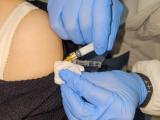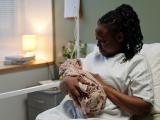Oct 1, 2009 (CIDRAP News) – Though the nation is going into its second wave of the H1N1 pandemic armed with crucial improvements such as better vaccine capacity, remaining challenges in medical surge and vaccine distribution could hamper response now and into a third wave, preparedness experts said today.
Hospitals across the nation vary in their ability to bear the burden of mounting H1N1 cases, the experts said at a press conference during which they unveiled a 38-page report from Trust for America's Health (TFAH), a nonprofit, health advocacy group based in Washington, DC.
Fifteen states, including Arizona, Connecticut, and Oregon, could run out of hospital beds by the fifth week of the second wave if 35% of the population gets sick with pandemic flu. Twelve states—among them New Mexico and North Carolina—could reach or exceed 80% of their capacity.
Jeff Levi, PhD, TFAH executive director, said some health facilities in big cities were overwhelmed during the early stages of the pandemic. "Our point is that how readily even a mild pandemic can overwhelm the system," he said. "We need a better system for addressing these issues, and some states are beginning."
TFAH authors based their projections on a 35% attack rate, which is a planning projection at the low end of the range of scenarios included in an Aug 24 report by the President's Council of Advisors on Science and Technology (PCAST). The TFAH authors used the Centers for Disease Control and Prevention's (CDC's) FluSurge modeling program to estimate the number of hospitalizations in each state.
However, they said erosion of the public health funding and workforce that has accelerated over the past few years will make it difficult to meet the challenges, unless steady federal funding streams, such as those that support police and fire services, are established for public health departments.
Robert M. Pestronk, MPH, executive director of the National Association of County and City Health Officials (NACCHO) said periodic funding infusions are important, but the approach isn't helping build a strong public health system. "There isn't any end point in preparedness. It requires sustained funding," he said.
According to a recent survey from NACCHO, budget cuts forced public health departments to eliminate 8,000 positions between January and June of this year, which reflects a larger loss than all of 2008.
Levi said a strong pandemic vaccine delivery performance from states might help blunt some of the impact on hospitals. However, a 2008 federal report on state pandemic plans revealed that 21 states had gaps in their preparations to handle mass vaccinations. "It's a complicated task, even in the best of circumstances," he said.
Adding to the vaccination challenge, public health officials may have a hard time reaching risk groups with vaccine messages, because some in the priority scheme, especially children, young adults, and members of minority groups, haven't routinely been targeted for seasonal flu immunization, Levi said.
He added that public health systems can also help reduce the burden on hospitals by getting higher-profile messages out about when to seek medical care for pandemic H1N1 infections,
- Some of the other pandemic challenges addressed in the TFAH report include:
- Antivirals: some states have limited stockpiles because of budget constraints and other obstacles
- Surveillance: current systems are outdated, don't track flu in real time, and aren't ideal for identifying clusters or monitoring severity
- Medical equipment: 25 million N-95 respirators were released from the federal stockpile at the beginning of the outbreak, with no action to replace the supply, which could be difficult because of limited availability.
Today's TFAH report included recommendations to improve response to the current and future pandemic waves. For example, the authors recommended that states and localities refine their plans for rapid vaccine distribution and that the federal government allocate more resources for vaccine delivery, especially if insurers don't provide adequate coverage.
The experts urged public health department to extend their vaccine campaigns beyond the flu season to help prepare for a potential third wave of the pandemic.
States should at least purchase enough antiviral supplies to cover their at-risk populations, and the federal government should consider making antiviral stockpiling solely its responsibility, the report advised.
Though federal officials have been working hard to improve surveillance to monitor the spread of the pandemic H1N1 virus, the TFAH authors said officials should consider funding and implementing detailed surveillance improvements outlined in the PCAST report.
Longer-term improvements should include the establishment of regional consortiums to organize and plan for health emergencies, as well as redoubled efforts, such as overtime incentives, to develop a medical surge workforce.
The most important improvement, though, would be a steady funding stream to support public health preparedness, Levi said. "We're trying to surge a public health system that has been critically hampered," he said.
See also:
Oct 1 TFAH report on H1N1 challenges
Aug 24 CIDRAP News story "Presidential panel calls for planning czar, faster vaccine"
Sep 21 NACCHO survey on public health workforce job losses


















